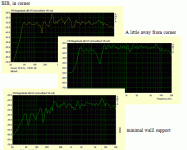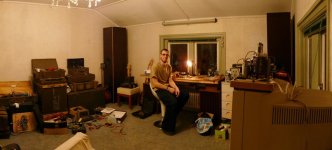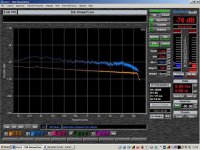I measured a pair of BIBs in my living room. The response was much more flat than I expected, but like all speakers very dependant on positioning. (sine sweep with no tricks, only 1/6 octave smooting)
I guess most horns (or dipoles for that matter) are a little more difficult to get to provide consistent results than more conventinal boxes.
SveinB
I guess most horns (or dipoles for that matter) are a little more difficult to get to provide consistent results than more conventinal boxes.
SveinB
Attachments
Not bad at all.  Especially with only 1/16 octave smoothing. I wouldn't mind a higher resolution copy of those if possible?
Especially with only 1/16 octave smoothing. I wouldn't mind a higher resolution copy of those if possible?
Placement sensitivity is probably the killer for these pipes -they rely on the room so much, and they do need more setting up that a lot, but once you do, they're not really much worse than a BR or similar & better than a lot.
Placement sensitivity is probably the killer for these pipes -they rely on the room so much, and they do need more setting up that a lot, but once you do, they're not really much worse than a BR or similar & better than a lot.
Successful horn enclosures are extremely precise designs and mind numbingly difficult to do justice to. The BIB can only ever be considered a gross approximation to a true horn, with a gross approximation to the performance of a true horn. It is highly unsatisfactory to design a speaker which will only work in one particular spot in a limited range of rooms. It is a quarter wave design which will display at least some of the negative characturistics of that class of enclosure. ML- brings consistency to the BIB and I would never consider building one without mass loading it.
Bare in mind that the original BIB article on the Fullrange Driver message board gives no specific guidance on what dimensions to build the BIB to, other than a overall line length. The builder was reluctant to give such advise because he considered the build a craft rather than a specific science.
Having said all that, I love my ML-BIB pipes, and I have some doubts that I will ever hear another set of speakers which I will like more.
Shoog
Bare in mind that the original BIB article on the Fullrange Driver message board gives no specific guidance on what dimensions to build the BIB to, other than a overall line length. The builder was reluctant to give such advise because he considered the build a craft rather than a specific science.
Having said all that, I love my ML-BIB pipes, and I have some doubts that I will ever hear another set of speakers which I will like more.
Shoog
Mr. Shoog, when you put a port on the BIB, I guess it is in reality converted to a TQWT (or would that be tapered half wave ...?).
Might be interesting to do a sim to see if it gives some real benefit compared to a more domestically acceptable shorter line cabinet.
Edit: The answer to this would be of some value to me, since the BIBs that both sounded and measured so well in the living room for a few days are now in winter-storage in my garage.
Svein.
Might be interesting to do a sim to see if it gives some real benefit compared to a more domestically acceptable shorter line cabinet.
Edit: The answer to this would be of some value to me, since the BIBs that both sounded and measured so well in the living room for a few days are now in winter-storage in my garage.
Svein.
Shoog said:Bare in mind that the original BIB article on the Fullrange Driver message board gives no specific guidance on what dimensions to build the BIB to, other than a overall line length. The builder was reluctant to give such advise because he considered the build a craft rather than a specific science.Shoog
Not surprising, because Terry didn't exactly design them. He took a design from the Fostex Craft Handbooks for the FF125K, converted the dimensions from metric to the nearest Imperial figure (for 1in material) and stuffed the RS 40-1354 into it.
They're still horns though. An extremely simple variation, and certainly not 'optimal' (which is an oxy-moron for BLHs anyway IMO) but technically that's what they are. It's not exactly alone in having a 1/4 wave fundamental. 99.99% of domestic bass horns are hybrids using QW action & shifting to horn loading as the acoustic impedance match at the mouth improves, otherwise they'd be ludicrously big (Kleinhorns anyone? And they're not quite big enough either). And in fairness to it, the Klipschorn & other corner horns only work properly in particular spots in a restricted number of rooms. So it's in good company WRT that too. They're hardly the most refined box on the planet, and the response will never be as smooth as a sealed or aperiodic box, but they're not half bad either if you design & position them correctly. If they aren't, that's not the fault of the cabinet as a type.
Svein_B said:Mr. Shoog, when you put a port on the BIB, I guess it is in reality converted to a TQWT (or would that be tapered half wave ...?).
Not exactly. To be a 1/2 wave it would have to be open at both ends. These are tuned to 1/2 wavelength of a given design frequency, but it's sealed at one end so the fundamental will always be 1/4 wavelength, albeit with both an odd and even harmonic structure.
[/i]Might be interesting to do a sim to see if it gives some real benefit compared to a more domestically acceptable shorter line cabinet.
Edit: The answer to this would be of some value to me, since the BIBs that both sounded and measured so well in the living room for a few days are now in winter-storage in my garage.[/B]
GM did a mildly mass-loaded B200 pipe that was 'only' about 56in tall, although the footprint is still pretty big (high Vas, high Q = big footprint). So yes, you can do a shorter pipe via mass loading. Bet it sounds good too.
LOL Shoog. That was a fun post to read. I enjoyed it very much. Yes, no box is perfect and yes the BIB is placement sensitive but if you are building speakers you know will go into corners they are an excellent choice, among others. I love my BIBs too, regardless of imperfections. Scott pointed out an excellent example, Klipsch. Mine are in corners. When they weren’t in corners they sounded thin. As the charts above show, in corners BIBs are pretty flat overall. Without corners they roll off in the bass. Thanks Svein for the great charts!
Shoog -which drivers are you running at the moment? IIRC you had some Isophons, or am I loosing it? (Got bird-flu at the moment, so the mind isn't what it should be).
Indeed your memory is good, they still are the Isophons. There a bit unusual for the BIB in that they are 8"x10" which is way bigger than what most people seem to be using in their pipes.
I have another pair of later vintage Isophons which have bigger alnico magnets. I intend to try them in a TL with reverse tapper. I did an experiment with this style enclosure and my impression is that the reverse tapper TL's may have the potential to deliver tighter bass.
As the charts above show, in corners BIBs are pretty flat overall. Without corners they roll off in the bass. Thanks Svein for the great charts!
Maybe it would be more accurate to say that they ripple in the bass.

Shoog
Hi !
I'd like to report back on my initial problem;
placing the BiB's in the corner helped a lot,
and last night I made a quick notch filter as discribed elsewhere
in the FR8c thread, a parallel network of a 1,0mH aircore coil,
a 3uF cap and a 10ohms resistor, placed in series with the
positive terminal of the speaker... This works like a charm !!
the rising responce, giving (at loud levels) a nasty shouting in
the vocal range, is really smoothed-out. This helps to bring
the midbass more to the front, the balance is far better now.
Didn't notice any mayor change in the micro-detail-department,
e.g. breathing of singers or guitar-slides (grabbing another fret)
are still there... Even with these filter parts from old hifi speakers!
(Got a big basket of old filterboards from wharfdale, bose, philips,
fane, jbl.... see, it pays to keep this junk!!)
Oh, by the way;
my girl has got a new digital camera and last night she was
experimenting with panoramashots. Behold my hobbyroom!
Cheers,
Empee
I'd like to report back on my initial problem;
placing the BiB's in the corner helped a lot,
and last night I made a quick notch filter as discribed elsewhere
in the FR8c thread, a parallel network of a 1,0mH aircore coil,
a 3uF cap and a 10ohms resistor, placed in series with the
positive terminal of the speaker... This works like a charm !!
the rising responce, giving (at loud levels) a nasty shouting in
the vocal range, is really smoothed-out. This helps to bring
the midbass more to the front, the balance is far better now.
Didn't notice any mayor change in the micro-detail-department,
e.g. breathing of singers or guitar-slides (grabbing another fret)
are still there... Even with these filter parts from old hifi speakers!
(Got a big basket of old filterboards from wharfdale, bose, philips,
fane, jbl.... see, it pays to keep this junk!!)
Oh, by the way;
my girl has got a new digital camera and last night she was
experimenting with panoramashots. Behold my hobbyroom!
Cheers,
Empee
Attachments
Shoog said:Indeed your memory is good, they still are the Isophons. There a bit unusual for the BIB in that they are 8"x10" which is way bigger than what most people seem to be using in their pipes.
Shoog
Bigger the better IMO. So long as the pipe's large enough to take them, life is good.
DaveCan said:Nice sized room Empee... If those are the BIB's in the corners in that pic? you may want to try toeing them out some, instead of firing straight down each wall.. Dave
Dave,
You mean toe-in (ie point the drivers more at the listener) as opposed to toe out (point the drivers at the side walls)?
dave
Hi there !
Smal update-
I got a copy of SMAART Live 5.4.0.0 and bought myself a measurement micorphone
(Behringer ECM 8000).
Placed the mic at listening position and played pink noize mono over two channels
(e.g. the same signal out of both speakers) and took a graph.
I've been experimenting with notch filters and low-budget dampening my room, and here's my result so far !
(orange = reference signal, blue = microphone signal)
Now I'm new to measurement stuff so if there's anything
I might be doing wrong wich could be influencing the result,
please let me know!
Smal update-
I got a copy of SMAART Live 5.4.0.0 and bought myself a measurement micorphone
(Behringer ECM 8000).
Placed the mic at listening position and played pink noize mono over two channels
(e.g. the same signal out of both speakers) and took a graph.
I've been experimenting with notch filters and low-budget dampening my room, and here's my result so far !
(orange = reference signal, blue = microphone signal)
Now I'm new to measurement stuff so if there's anything
I might be doing wrong wich could be influencing the result,
please let me know!
Attachments
Scottmoose said:Ah. Yes, that rising response is a bit of an issue with the Hempster -it's not the flattest driver on the planet unfortunately. Glad you've got them dialled in to taste now though.
Well, neither is the Fostex 207. As I've said, I've seen them measured on identical test baffles, and they are +/- .5db, with the exception of things like the edge nulls being in different spots and different LF rolloffs. It's always interesting to see measurements taken identical conditions. If anybody has done their own comparison measurements under the same conditions, I'd love to see them.
Empee, you broke them in good didn't you? The BIB restricts excursion so much that it'll take a couple hours of ear bleeding levels to get 'em sounding decent. However, out of the box with plenty of low frequencies and a constant 2-5 watts (gets my test amp plenty warm, so I often only do 2 hour chunks) will loosen them right up.
The unfilted fullranger sound (especially the big ones) isn't for everbody, many of the multiway guys hate all of 'em. Some of us accept their faults and like what they do well.
pj
Oh, I give 'em a good beat every once in a while allright 
when I got my drivers I layed them in their cardboard boxes,
connected testing clips to their terminals and played
continues music (winamp on autocue) in chunks of 8 to 16 hours for a total of 80 hours or so.
Then my BiB's were complete and fitted them,
so I guess I'm now on 130+ hours of music on them.
And I do like some hardrock, of coarse at appropiate levels
actually, on of my favorite bands to play when people
dont believe in my "4 watts into 8inch fullrange speakers story" is Rammstein...
You gotta see the looks on their faces when that first powercord comes in.....
hehehehe
But really,
during last week the drivers really opened up
The change is so subtle yet so enormous
The people in the jazzclub on the background of Oscar Peterson's
track "sometime I'm happy" really make a living stage when I close my eyes
Cheers,
Empee
when I got my drivers I layed them in their cardboard boxes,
connected testing clips to their terminals and played
continues music (winamp on autocue) in chunks of 8 to 16 hours for a total of 80 hours or so.
Then my BiB's were complete and fitted them,
so I guess I'm now on 130+ hours of music on them.
And I do like some hardrock, of coarse at appropiate levels

actually, on of my favorite bands to play when people
dont believe in my "4 watts into 8inch fullrange speakers story" is Rammstein...
You gotta see the looks on their faces when that first powercord comes in.....
hehehehe
But really,
during last week the drivers really opened up
The change is so subtle yet so enormous
The people in the jazzclub on the background of Oscar Peterson's
track "sometime I'm happy" really make a living stage when I close my eyes
Cheers,
Empee
Hi Scott - Are the Jordan JX92 dimensions on Godzilla's site still current. I've looked at GM's spreadsheet but get somewhat different results. (This is probably because I'm not sure what driver the example is for, so may be substituting Vas and Qts in the wrong places in the calculations.)
- Status
- This old topic is closed. If you want to reopen this topic, contact a moderator using the "Report Post" button.
- Home
- Loudspeakers
- Full Range
- BiB - responce ripple reduction ?


